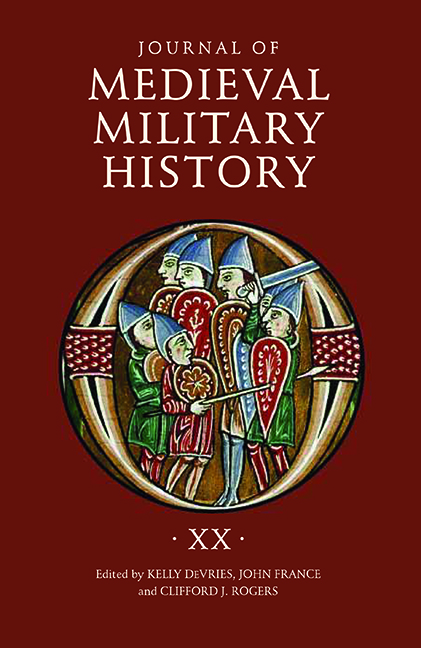Book contents
- Frontmatter
- Contents
- List of Illustrations
- 1 De velitatione bellica and the Georgian Art of War During the Reign of David IV
- 2 The Afterlife of the Medieval Christian Warrior
- 3 More Accurate Than You Think: Re-evaluating Medieval Warfare in Film
- 4 Raising the Medieval Trebuchet: Assembly Method and the Standing of a Half-scale Machine
- 5 Cum Socio Eiusdem: Military Recruitment in the Armies of Edward I Among the Sub-Gentry
- 6 Two Walls of Protection: Queen Elionor of Sicily and Bishop Berenguer de Cruïlles of Gerona During the 1359 Naval Campaigns of The War of the Two Pedros
- 7 The Lancegay and Associated Weapons
- 8 “I intend to give him battle.” Battle-Seeking in a Civil War Context: Toro (1476)
- 9 Discovery of an Early Sixteenth-Century Battle Plan from the Archdiocesan Archive in Ljubljana
- List of Contributors
- Journal of Medieval Military History 1477-545X
4 - Raising the Medieval Trebuchet: Assembly Method and the Standing of a Half-scale Machine
Published online by Cambridge University Press: 07 October 2022
- Frontmatter
- Contents
- List of Illustrations
- 1 De velitatione bellica and the Georgian Art of War During the Reign of David IV
- 2 The Afterlife of the Medieval Christian Warrior
- 3 More Accurate Than You Think: Re-evaluating Medieval Warfare in Film
- 4 Raising the Medieval Trebuchet: Assembly Method and the Standing of a Half-scale Machine
- 5 Cum Socio Eiusdem: Military Recruitment in the Armies of Edward I Among the Sub-Gentry
- 6 Two Walls of Protection: Queen Elionor of Sicily and Bishop Berenguer de Cruïlles of Gerona During the 1359 Naval Campaigns of The War of the Two Pedros
- 7 The Lancegay and Associated Weapons
- 8 “I intend to give him battle.” Battle-Seeking in a Civil War Context: Toro (1476)
- 9 Discovery of an Early Sixteenth-Century Battle Plan from the Archdiocesan Archive in Ljubljana
- List of Contributors
- Journal of Medieval Military History 1477-545X
Summary
The counterweight trebuchet was the heavy artillery of the Middle Ages, using gravity to hurl projectiles and destroy fortifications. Some trebuchets may have been almost ninety feet tall, and several likely threw stones weighing more than three hundred pounds farther than four hundred yards. While replica historical machines have been made in modern times, the methods of building and assembling trebuchets have not been widely published. Learning how these machines were built can tell us about the logistical difficulties of sieges and the sophistication of medieval engineering and technology. Information gleaned from several extant technical drawings and manuscripts, and the traditional techniques seen in medieval buildings and ships, was used in conjunction with experimental history to reproduce a small machine at full scale (thirty-three feet tall). Here, I show how something so large can be assembled with traditional hoisting equipment that dates to ancient times. This project highlights the expert craftsmanship of the high-late medieval period and shows that engineers of the Middle Ages knew how to use simple machines to accomplish the complex task of assembling a large trebuchet.
Introduction
In 1304, engineers and craftsmen under the English king Edward I constructed one of the largest and most famous pieces of mechanical artillery used in history. Named Ludgar, or Warwolf, this machine was a trebuchet, designed to use the power of a falling counterweight to launch stone projectiles and assault Stirling castle, held by the Scots. Pierre de Langtoft writes, in his chronicle: “In the midst of these doings the king causes to be built of timber a terrible engine, and to be called Ludgar; and this at its stroke broke down the entire wall.” The Scots, having previously watched the machine being assembled, and at the mercy of bombardment by twelve other trebuchets, offered to surrender, but Edward refused to let anyone leave the castle until his prized engine had bombarded it. Edward's machines at Stirling reportedly launched stones weighing up to three hundred pounds and demolished a wall of the castle.
Although we cannot know exactly how large Warwolf was, a thirteenth-century drawing by Villard de Honnecourt, as well as the physics of such a machine, suggest that it was more than sixty feet tall and used more than fifteen tons of counterweight.
- Type
- Chapter
- Information
- Journal of Medieval Military HistoryVolume XX, pp. 69 - 108Publisher: Boydell & BrewerPrint publication year: 2022



